|
February 12, 2023
Dear Neighbors and Friends,
I hope that you and your loved ones are doing well, staying healthy, and looking out for your neighbors and friends during this past week.
This past week was the fourth full week for this legislative session. While the headlines have been full of a scandal regarding OLCC (Oregon Liquor and Cannabis Commission) officials getting the inside track on some very rare and expensive liquor (no, I was not a recipient), we’ve been quietly plugging along, doing the people’s business.
In tonight’s newsletter you’ll find examples of some of that work from last week and looking forward to next week in the areas of Education, Climate Action, Housing, and Prison Reform.
On the COVID front, we’re again seeing small increases in most of the COVID metrics. They’re still well below the levels we saw a month ago, so we seem to remain in line with the most recent OHSU forecast. (I’m not sure why, but we haven’t seen an update to the forecast for several weeks.) According to our State Epidemiologist, Dr. Dean Sidelinger, in a recent press conference, our situation here in Oregon does seem to be improving. More Oregon counties have moved from Medium Risk to Low Risk—a status now held by 33 of our 36 counties.
Until next week, please do your best to stay happy, healthy and safe. And let me know if you have any questions or thoughts about anything in this week’s newsletter.
More Senate Floor Sessions in the Works
I mentioned in last week’s newsletter that the Senate will likely need to meet more frequently if bills are required to be read in their entirety prior to voting on the floor. (And to remind you, a bill is made up of the section of statute that is being modified, along with the changes being made. It is almost always the case that nearly all of the content of the bill is existing language that is NOT being changed. That’s why they take so long to be read.)
During this past week’s floor sessions on Tuesday and Thursday, every bill passed on near-unanimous votes. The Republicans’ insistence on bill-reading was not designed to stop any of these bills. It's a political strategy to slow down the legislative process in general and thereby cause us to miss the legal deadlines to get important Democratic priorities over the finish line (even if that means that Republican priorities will also die).
To keep that from happening, we are indeed going to meet more frequently than had been originally scheduled. Henceforth, the Senate will be meeting four days a week instead of twice a week, and that may need to be extended to five. This coming Thursday’s session will be longer than usual in order to accommodate a 54-page omnibus bill that “makes nonsubstantive and technical changes in Oregon law,” SB 316.
Here’s the notice that senators received on Thursday afternoon:
Senators,
The Senate plans to convene for floor sessions on the following days next week:
Monday, February 13 at 11:00 AM
Tuesday, February 14 at 11:00 AM
Wednesday, February 15 at 11:00 AM
Thursday, February 16 at 10:30 AM
--No Floor Session Friday, February 17--
On Thursday, February 16, please note the earlier planned meeting time of 10:30 AM and that floor session may run to 12:45 PM or so to allow consideration of a measure.
Please send any completed excuse request forms to Senate President Wagner and Carol Suzuki in the Senate President’s Office.
Thank you for your flexibility in allowing the Senate to convene more frequently beginning next week.
The Week in Senate Education
The fourth week of Senate Education 2023 was full of action.
- Tuesday’s meeting was devoted to four bills focused on challenges faced by Oregon students with disabilities, particularly those whose districts are not providing them with full school days, an issue addressed in SB 819. The bill makes it clear that a student cannot be put on shortened school days if their parent disagrees. In order to accommodate all of the parents and students who were expected to sign up to testify (and who ultimately did), the hearing was doubled in length. The bill, which is sponsored by six of the seven committee members, is scheduled for a vote this Thursday. Amendments have been requested.
- On Thursday we had hearings on several bills and voted out the following bills (on unanimous or near-unanimous votes):
-
SB 272, which provides in-state tuition for COFA students from Micronesia studying at OHSU. It now goes to the Senate floor for a vote.
-
SB 427, which is an important step in creating the new Department of Early Learning and Care. It now goes to the Senate floor for a vote.
-
SB 521, which makes a change to the corporate kicker that provides more flexibility in the educational programs that it can fund. It goes to Ways and Means.
-
SB 276, which continues funding for the school vision checks performed in partnership with the Lions. It goes to Ways and Means.
-
SB 424, which prohibits colleges and universities from refusing to provide students with their transcripts if they owe fines or fees. This was one of the recommendations coming from the Joint Task Force on Student Success for Underrepresented Students in Higher Education. It goes to the floor for a vote.
And Coming Up On Tuesday: Tackling the Educator Shortages
I’ve written before about the work that’s been going on for more than a year to address the serious shortages that we’ve been experiencing in our educator workforce. Here's a timeline of that work.
On Tuesday we’ll be holding a public hearing on the bill that incorporates the recommendations of the bicameral, bipartisan work group that’s been focused on this problem. That bill is SB 283, one of those “placeholder” bills that calls for a study of the educator workforce. The actual content is in the -3 amendments, which have just been drafted and posted.
Here is a "one-pager" that describes the contents of SB 283, along with SB 279, which we’ll also be hearing that day. It authorizes Oregon to join a new interstate compact on teacher licensure, allowing teachers in member states to more easily transfer their licenses if they move to a new state.
If you’re interested in signing up to testify, here's a link to Tuesday’s meeting.
On Thursday we'll be hearing a bill related to university board governance and one that would merge the Teachers Standards and Practices Commission (TSPC) agency into the Oregon Department of Education.
Coming Up on Wednesday: Natural Climate Solutions
Another of my priority bills will be heard this week. It’s SB 530, the bill that focuses on the importance of “natural climate solutions”—i.e., the use of our natural and working lands as tools to get carbon out of the atmosphere via natural storage and sequestration. Think of the forests (urban and rural), rangelands, wetlands, agricultural lands, and coastal marshes with which Oregon is particularly blessed. We’ve appropriately been focusing on reducing our consumption of fossil fuels and emissions as climate action, but Oregon has the capacity to do much more through our beneficial use of our natural and working lands.
SB 530 clarifies that role, directs further research and an inventory of our current state of sequestration, sets up the design of a timetable for gradual increases, uses the Oregon Global Warming Commission as a coordinating body for the different state agencies engaged in this work, and creates a fund to get resources out to small farmers and timber owners to help them adopt practices that lead to greater sequestration. This fund will leverage a great deal of the federal dollars that are now being made available to promote these practices.
It’s very exciting. This is an area of climate action that few states are pursuing in a comprehensive way. SB 530 has been chosen as a priority of the Oregon Conservation Network.
SB 530 will be heard in Senate Natural Resources on Wednesday morning at 8 a.m. If you’d like to testify orally or in writing, here’s the page for that day's agenda.
Compassionate Medical Release Gets Some Attention
SB 520, the Compassionate Medical Release bill, has gotten some press and radio attention lately. I wrote a few weeks ago about a tour that I organized to the Oregon State Prison that included legislators and a formerly incarcerated hospice worker. That tour was the subject of a recent article in BOLTS Magazine. That story was then pick up and amplified in a segment of OPB's Think Out Loud.
This past Friday I led another group of legislators, staff, and another former adult in custody to Coffee Creek Correctional Facility in Wilsonville, the state’s prison for women. Again, it was extremely eye-opening and made it even clearer that this bill really must pass as soon as possible. We got to spend time with a woman whose MS has kept her incapacitated, bed-ridden, and in need of constant care. The Chief Medical Officer of the Department of Corrections let me know that her condition will only continue to degrade over time. She really should be in an outside facility, where more appropriate levels of care (funded by federal Medicare/Medicaid, which cannot be used for those in custody) can be provided.
SB 520 will be heard in Senate Health Care sometime soon.
And here’s a photo of a few of us from Friday’s tour:
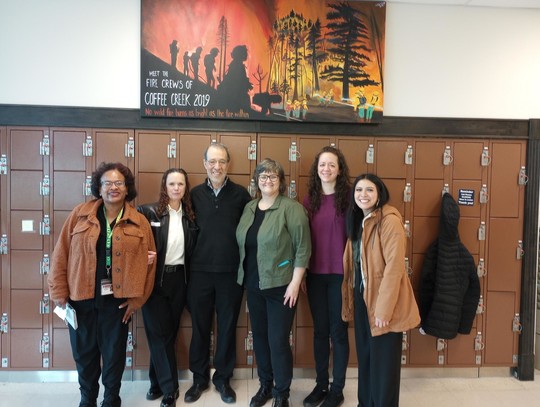 Coffee Creek Superintendent Nichole Brown, former AIC Kyle Black, me, Senator Janeen Sollman, my staffer Clare Lanusse, and Maria Gomez from Senator Sollman's Office.
Housing Amendments Released
As you know, one of this legislative session’s primary focuses will be on housing and homelessness. The first of this sessions big housing bills, HB 2001, is being heard in the House Committee on Housing and Homelessness this Tuesday at 8 a.m. It’s another placeholder bill, whose actual content is located in the -1 amendments, which have just been posted. Here's a description of what’s in them.
If you’re interested in testifying on the bill, you can sign up here.
 Congresswoman Suzanne Bonamici Is Lead Democrat on Education Subcommittee
In last week’s newsletter I reported on Congressman Cliff Bentz’s election to serve as Chair of the House Natural Resources Subcommittee. We’ve just received word that another former colleague of mine, the good Congresswoman Suzanne Bonamici, will be heading up another important subcommittee. Here’s the announcement from her office:
Dear Friend,
Happy New Year!
I am writing to update you on Congresswoman Bonamici’s recent election to a leadership role on the House Education and the Workforce Committee to serve as the lead Democratic member of the Early Childhood, Elementary, and Secondary Education Subcommittee. The Congresswoman will also serve on the Higher Education and Workforce Development Subcommittee. In each of these roles, the Congresswoman will continue to work on issues she has long championed on behalf of Oregonians. The full press release from our office is [linked here].
The Congresswoman looks forward to your feedback and suggestions for her work on the Education and Workforce Committee. She looks forward to strengthening public education and building an education system where all students can succeed, regardless of what path they take.
For more information, you can contact the Congresswoman’s office here.
ON THE COVID FRONT
Weekly Data Report:
OHA now updates and reports COVID metrics once a week, on Wednesdays. Here are the most recent set of weekly results, for this past week from 2/2/23 through 2/8/23.
This week’s report shows a second week of increases here in Oregon.
- The 7-day average for newly reported infections went up again last week, from 330 the previous week to 385 reported infections per day this last week. The number of new cases is likely an undercount, as many people are using home tests to determine their infection status but are not reporting those results.
- Average test positivity also went up during the last week, to 9.2% vs. the previous week’s 8.8%. This number probably skews high because it likely reflects a higher proportion of people showing COVID symptoms (and thus reporting or going in for a test, rather than self-testing and never reporting).
- On Wednesday there were 226 COVID-19-related hospitalizations statewide, a small increase from 219 the previous Wednesday. Hospitalizations are now our best indicator of disease spread. Again, however, most of these hospitalizations are not in and of themselves due to COVID—most are those who tested positive after having been admitted for other reasons.
- The number of COVID patients in Oregon’s ICUs on Wednesday saw a small increase--from 24 to 26.These are the most serious COVID infections.
- There were just 19 COVID-19-related deaths reported during the last week, a big decrease from the previous week’s 67. However, it’s important to remember that many of every week’s reported deaths actually occurred in earlier weeks but were just reported to the state, and others that likely occurred have yet to be reported. The newsletter’s final graph shows when the deaths actually occurred, and you’ll see that the number of COVID deaths each day continues to remain relatively low.
Weekly County Report: Nearly All Counties Back to Low Risk
The CDC assigns risk levels based on a combination of the number of new COVID cases and the number of people in hospital for COVID.
According to the CDC Daily Counter (updated each Thursday), three counties moved back from Medium Risk to Low Risk. Morrow, Umatilla, and Malheur (for the fourth straight week).
The remaining 33 Oregon counties are at Low Risk.
We can also track the cases, deaths, and test positivity rates for each county at this website.
Positivity rates for the three Portland-area counties were mixed last week. Clackamas County in now at 9.9% (down from 11.3% the previous week). Multnomah County has gone down to 6.8% (from 7.1%). Washington County has gone up to 9.1% (up from 8.3%).
Remember that these are all based on reported test results, and so are more likely to be a little higher than the total percent positivity (i.e., if one were to include all tests taken).
This Week’s Wastewater Monitoring Report: Percentage of Increases Rises a Little
With testing reports giving us just a fraction of infections out there, wastewater monitoring has become a more reliable indicator of the amount of virus in cities around the state. That report is updated each week.
This week’s report, updated on Wednesday, shows the percentage of increases and sustained increases rose a little to 13% (from 10% the previous week). Decreases and sustained decreases were at 10%. Seventy-seven percent showed no change (up from last week’s 70%).
Albany, Bend, and Siletz are the cities showing sustained increases in last week’s report.
Another Monthly Report from Dr. Sidelinger: Oregon’s Virus Situation Continues to Improve
Dr. Dean Sidlinger, Oregon’s State Epidemiologist, provided an update on COVID and the other respiratory viruses in Oregon in a press conference on Thursday. The bottom line: the situation in Oregon is improving.
As the end of the federal health emergency declaration approaches its end (it ends on May 11), and the formal wind-down of the pandemic response begins, Dr. Sidelinger reported the we’re seeing “more positive changes that speak to the normalization – and manageability – of COVID-19 in our lives.”
Key takeaways from Thursday’s press conference include the following:
- Hospitalizations for COVID-19, RSV and influenza have dropped significantly and should continue to drop in the coming weeks. Hospitals remain strained as many people continue to seek care for other medical conditions.
- The mask mandate in health care settings may be lifted in the next couple of months.
- 1.5 is likely the predominant COVID-19 subvariant in Oregon, and the bivalent booster provides significant protection against severe illness caused by XBB.1.5.
- We may see more flu cases in the coming weeks. Oregonians who have not yet received a flu vaccine should consider doing so ASAP.
- Mpox cases in Oregon have dropped and are holding steady at zero to two cases per month. The total number of mpox cases in Oregon is 270, with cases in 12 counties since the outbreak began in June 2022.
Here's OHA's summary of the press conference. And here's a link to watch the press conference.
Here’s reporting on Dr. Sidelinger’s comments by Lynne Terry of the Capital Chronicle. And here’s reporting by Abe Asher of the Portland Mercury.
COVID Q & A from OHA (from OHA weekly newsletter)
Dr. Paul Cieslak, OHA senior health advisor and medical director, Communicable Diseases and Immunizations, and Dr. Melissa Sutton, OHA’s medical director of respiratory viral pathogens, answered today’s questions.
Q: I have read that there are reports of an increase in platelets in people receiving COVID-19 vaccinations. As someone with a blood cancer, I'm concerned about this possibility. Normally, I'd seek protection from COVID-19, but not at an increased risk of strokes and clots. – Teresa, Eugene
A: “I’m sorry to hear about your cancer. To my knowledge, increased platelet counts have not been associated with COVID-19 vaccines. We conferred with the Centers for Disease Control and Prevention specifically about this question, and they affirmed that there’s been no evidence of an association of increased platelet counts with COVID-19 vaccines.”
Q: The bivalent booster has been available for children under 5 for nearly two months, yet it is still not available in Deschutes County. Why is this and when will it be available? – Rachel, Bend
A: “Hi Rachel. The bivalent booster for children under 5 is widely available across Oregon, including Deschutes County. We recommend checking with your pediatrician about getting your child boosted, but you can also visit Vaccines.gov and search for vaccination locations by vaccine brand and ZIP code. One of the best places to check is your county health department. The Deschutes County Health Services (DCHS) website lists a series of community vaccination clinics in Bend, La Pine, Redmond and Sisters. The site also displays the clinics on an online calendar. They recommend that for vaccinating children under 5 you should make an appointment by calling the DCHS COVID-19 Hotline (541-699-5109), Mon. – Fri., 8 a.m. to 3 p.m.”
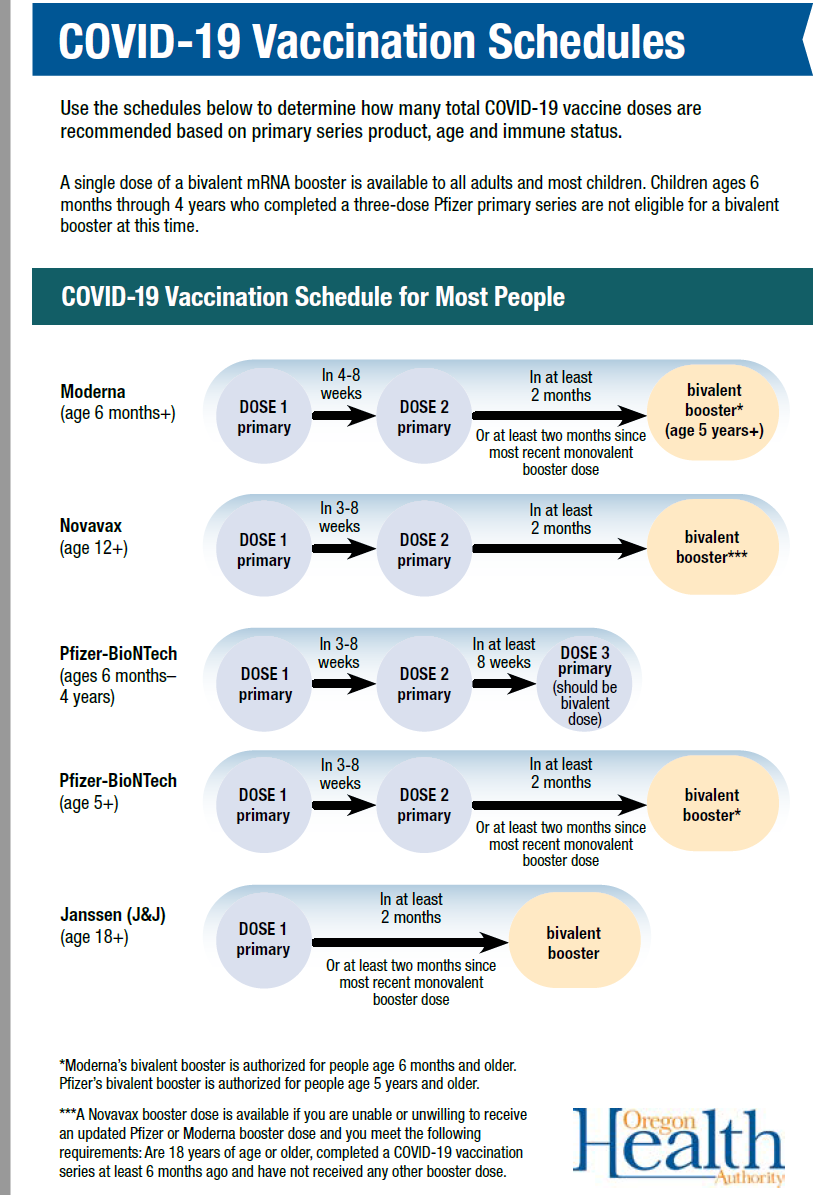
Additional COVID Updates and Links
- Here’s the latest on COVID in Oregon from the Oregonian.
- From the New York Times, why the odds are low why the odds are low that we’ll soon be seeing a promising new COVID drug. [This article may only be available to Times]
- From the Washington Post editorial board: .the specter of Long Covid remains for millions.
- The federal government plans to stop purchasing COVID vaccines for the public in the fall. Here's what that means.
- You won’t be surprised to learn that doctors aren't immune to political biases when it comes to COVID.
- Though it’s certainly not always the case, a healthy lifestyle prior to infection has been linked to lower risk of Long COVID.
- Here are a number of recent statistics and polling results related to COVID from the Kaiser Family Foundation.
- I recently linked to an article touching on the potential risk of COVID mutations from monupiravir, a drug used to treat COVID patients, particularly those who are unvaccinated. Here's more background and explanation in a recent, very readable article in Science.
- You likely remember how unprepared we were in the early days of the pandemic when it came to PPE, most of it coming to us from other countries. We’ve just learned that PPE manufacturers have formed a consortium lobbying for more U.S. production./ (Yes, that means they’re calling for tax credits and a higher reimbursement rate for their products.)
- Researchers are finding that interferon injections are highly effective at warding off severe COVID symptoms for those who’ve been vaccinated.
- Sorry, two more COVID myths busted: No, egg yolks don’t prevent or cure COVID. And no, the current runup in the price of eggs is not the result of people hoarding eggs for COVID treatment or a plot by the federal government.



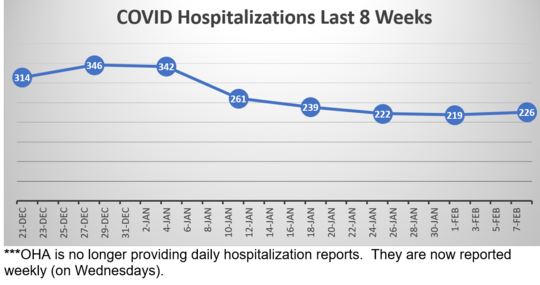
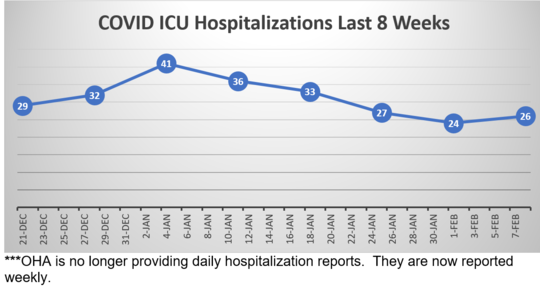
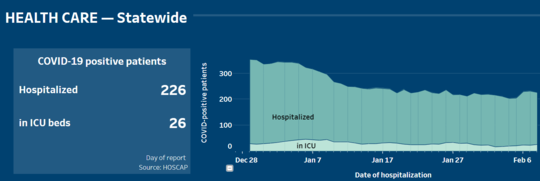


Here again are some COVID resources that you will find useful:
If the above links are not providing you with answers to your questions or directing you to the help that you need, please consider me and my office to be a resource. We’ll do our best to assist you or steer you in the right direction.
 Senator Michael Dembrow
District 23
email: Sen.MichaelDembrow@oregonlegislature.gov
web: www.senatordembrow.com
mail: 900 Court St NE, S-407, Salem, OR, 97301
|